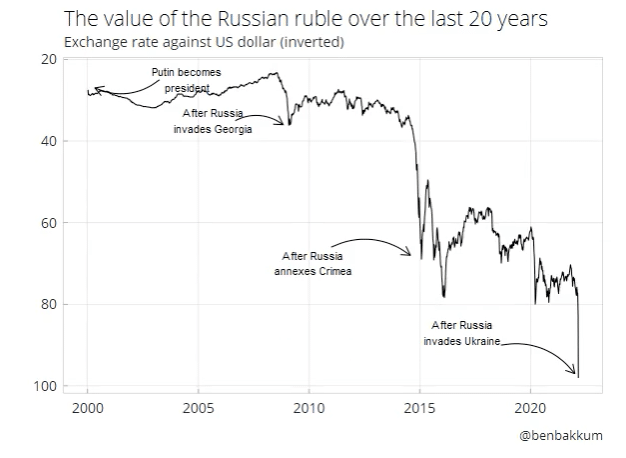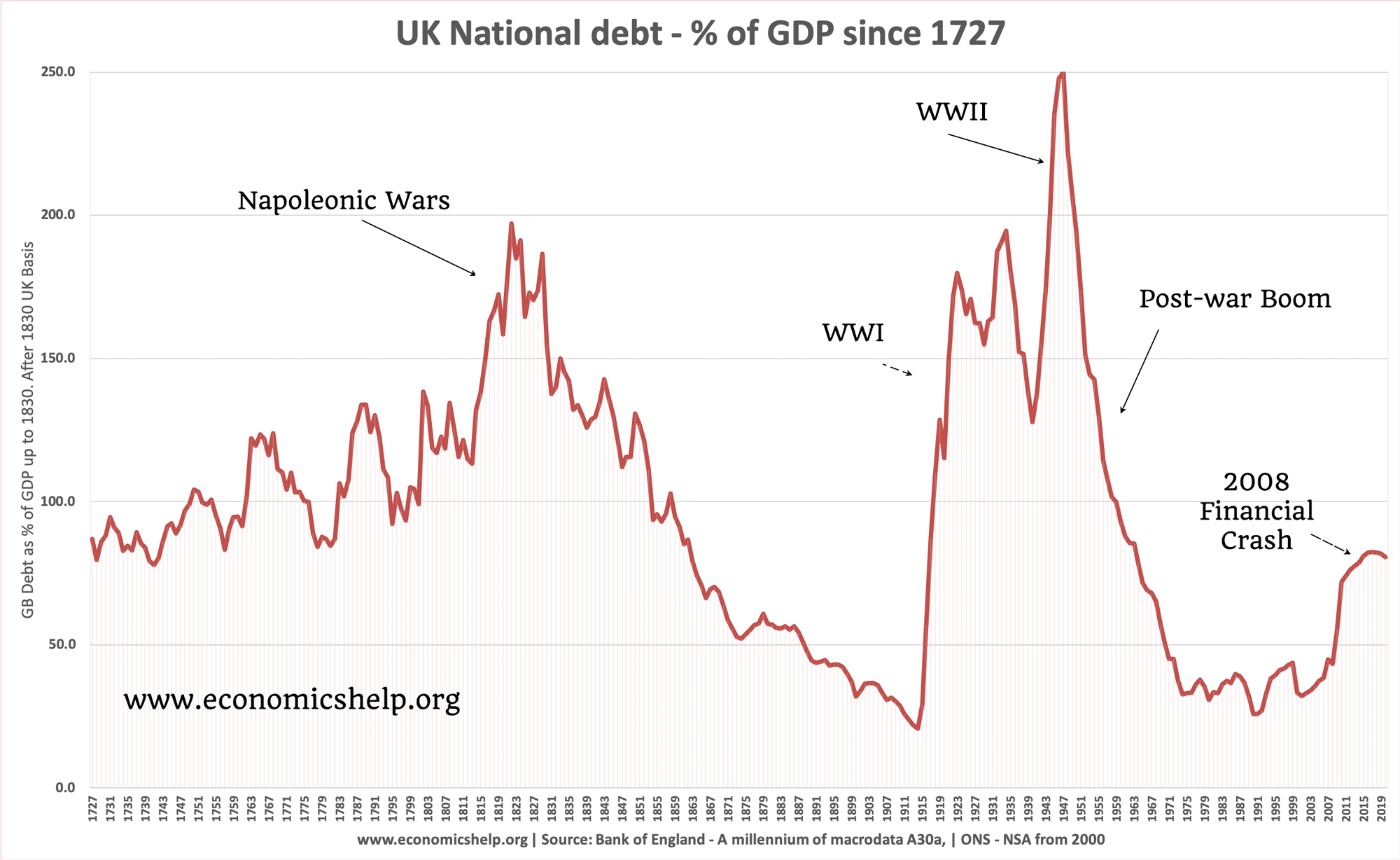Putting aside the very real human cost, war has also serious economic costs – damage to infrastructure, a decline in the working population, inflation, shortages, uncertainty, a rise in debt and disruption to normal economic activity.
From some perspectives, war can appear to be beneficial in terms of creating demand, employment, innovation and profits for business (especially when the war occurs in other countries.) However, when we talk about the ‘economic benefits’ of war we must be aware of the ‘broken window fallacy‘ – when we spend money on war, this creates demand, but also it represents a huge opportunity cost – rather than building bombs and rebuilding destroyed towns, we could have used this money to improve education or health care. For example, the opportunity cost of the Iraq war was estimated at $860 billion by end of 2009 (source: NY Times)
War and inflation
In many circumstances, war can lead to inflation – which leads to loss of people’s savings, rise in uncertainty and loss of confidence in the financial system. For example, in the US civil war, the Confederacy struggled financially to meet the cost of the war. Therefore, they started printing money to pay soldiers’ salaries. But, as they printed money, the value of money soon declined. High inflation hits middle-income savers the most as they see the value of their savings wiped out.
During the Second World War, the United States saw a rise in inflation because the economy was running close to full capacity, the high levels of government spending and shortage of workers saw inflationary pressures. During war, the economy can also experience cost-push inflation due to shortages of goods and services and rising price of raw materials like oil. (Interestingly inflation in the Second World War was limited by price controls and rationning)
If a country is devastated by war and the capacity to produce goods is sharply reduced, it can create the circumstances of hyperinflation as governments desperately print money to try and deal with the lack of goods. For example, with a devastated economy, in 1946, Hungary and Austria experienced the highest rates of hyperinflation on record.
War and oil prices
War can often lead to higher prices of oil because major conflict can threaten supplies.
For example, the Gulf war of 1990 led to rising oil prices. Prices rose from $21 a barrel in July to a post-invasion peak of $46 in Mid October. (though prices fell shortly after)
The 2022 Russian invasion of Ukraine led to a rise in the price of oil and gas, and this will lead to higher global prices for fuel. As Russia is a major supplier of oil and gas, economic sanctions on Russia in response to the invasion will reduce supply and put upward pressure on gas prices.
War and National debt
During war we often see a rapid rise in public sector debt. The government is willing to borrow a lot more than usual because – there is patriotic support for the war effort.
Both the First and Second World Wars were very costly for the UK. In both cases, the national debt rose very sharply. In the post-war period, debt continued to rise due to reconstruction and the creation of the welfare state.
UK national debt rose to 150% at the end of World War Two – but then rose to 240% by the early 1950s.
The UK relied on loans from the US during the Second World War and took many decades to pay them off.
For the US, which was not involved for the first two years, the rise in national debt was not as pronounced. The US profited from selling arms and equipment to the UK during the early years (though on generous lend-lease terms)
The financial cost of war
Although war can provide a temporary boost to domestic demand, it is important to bear in mind the cost of war. In particular the opportunity cost of military spending, the human cost of lost lives, the cost of rebuilding after the devastation of war. Also, it depends on the kind of war, how prolonged it was, where and how it is fought. For example, the US fought wars – WWII, Korean War, Vietnam War and it appeared that these wars led to a boost in domestic demand and some manufacturing companies did very well. However, we shouldn’t forget that these wars occurred on territories outside the US. The real devastation took place in Asia and Europe.
See: Cost of War
Cost of civil war
Civil war can have a devastating impact on the economic development of countries. Countries experiencing civil war will see a collapse in tourism, foreign investment and domestic investment. It can lead to shorter life-expectancy and lost GDP. A report entitled “Africa’s missing billions” (Oxfam, 2007) estimates the cost of war in Africa has been equal to the amount of international aid. A country like the “Democratic Republic of Congo” has experienced a particularly difficult war, which besides causing the deaths of about 4 million people, has cost it £9bn, or 29% of its gross domestic product.
The report also notes that ongoing war and increased availability of weapons can lead to increase in rates of armed violence and organised crime.
This is an example of the projected loss of GDP for Burundi during the civil war. It is calculated by an estimated pre-war trend of GDP and actual GDP. It shows that a decade of conflict is a major cause of falling GDP.
But, also it is worse than the graph shows because, during the war, a large percentage of GDP is spent on destructive military hardware. The decline in health services and education are likely to be even greater.
The aftermath of War?
War invariably leads to a legacy of debt and an army of demobilised soldiers. After the Second World War, the debt was not a constraint to growth and we had one of the longest periods of economic expansions on record. (Post-War Britain)
However, the aftermath of war is not always so positive. The UK struggled after the end of The Napoleonic war and after the end of the First World War. In the 1920s, the UK struggled with a long period of unemployment – returning soldiers found very poor employment prospects. Yet, after the Second World War, the US and Europe experienced full employment.
The German economy was ravaged by the aftermath of the First World War and the demand for reparation payments. Struggling to meet reparation payments, Germany resorted to printing money – leading to hyperinflation. The discord around the German hyperinflation of the 1920s sowed the seeds for political extremism and future wars.
However, after the Second World War, the Allies didn’t make the same mistake. The US gave generous aid to Western Europe – helping the rebuilding process and leading to the economic miracle of Europe, and Germany in particular.
Psychological costs
It is possible to estimate economic costs of war – cost of military, e.t.c. However, it is harder to estimate the psychological costs of war – the pain of death, suffering, fear and disability. A conflict can leave soldiers and civilians traumatised for the rest of their lives. In recent years, post-traumatic stress syndrome is more widely accepted, but putting a cost on how war negatively affects those involved, is difficult to do.
Economic benefits of wars
War can appear to have potential economic benefits. Though as already stated all these could be achieved without war.
- Full employment
- Higher economic growth
- Increased rate of innovation as the government invests in new technology, e.g. development of radar/jet engine in the Second World War could be used for peaceful purposes.
- Change in social attitudes. For example, women entering labour market after First World war.
In the 1930s, J.M. Keynes advocated government borrowing and government spending to reduce the mass unemployment of the great depression. However, it was only the onset of the Second World War, where there was the political impetus to pursue sufficient spending. In both UK and US, the economy soon reached full employment – often with shortages in key areas as men joined the army.

Graph showing a sharp fall in unemployment at the start of the Second World War.
In fact, one side effect of the First and Second World Wars was the growth in female employment. In 1914-18, women took on jobs, previously the sole reserve of men; this helped to change cultural attitudes and gain women the vote, shortly after the end of the First World War.
Possible unemployment
However, at the end of major wars, there is the danger that returning soldiers may struggle to find employment. After the end of the First World War, there was a major economic slump, and returning soldiers struggled to find jobs that had been replaced during the war.

A sharp rise in unemployment after the end of the First World War. The Versailles Treaty which demanded reparations from Germany did not help as it contributed to lower trade
1960s economic boom
In the 1950s and 1960s, the US was involved in major conflicts in Korea, Vietnam and Cambodia. Military spending took an increasing share of GDP and was partly responsible for strong domestic demand and high rates of economic growth. Companies involved in the manufacture of arms saw a rise in demand and profit.
See: War and the Economy
Economic costs of war in history
There was a time when war could be economically beneficial. In a mercantilist period before substantial trade, a way to improve the economy was to plunder wealth and land from other countries. So for example, the Viking invasions probably increased the wealth of the Viking economy in Scandanavia. Some men were lost in the fighting, but they gained unimaginable wealth, slaves and booty. The wars were quite cheap – there were no armament costs and the army could be self-sufficient. Therefore, the economic benefits of raiding countries could be greater than the economic costs.
However, modern war is very different. Firstly, with all the technology, it is very expensive to run. Modern armies need fuel, munitions and food. Secondly, the world is now much more interconnected with a nation’s wealth increasingly dependent on trade. If a country acts in an illegal war (like Russia 2022) it can face very painful economic sanctions.
A third point is that nationalism is a more potent force since the nineteenth century. Occupying armies are likely to face resistance from locals who refuse to be ruled by a foreign power.
In 1909 British author Norman Angell published a book “The Great Illusion” where he pointed out war in the twentieth century would lead to a net economic cost, whereas in the past, war may lead to economic gain. Of course, this does not mean wars stopped in 1909. Countries can be willing to go to war – for many other reasons. But, at least from an economic perspective, it is usually bad news.

Russian invasions led to sharp falls in the Ruble and falls in Russian living standards.
Costs of war – video
Related





good
Commenting on the basis of actual war experiences
Very helpful and best explanation on economic impact of war on whole website
The article is very well written and explains the consequences of WAR in very easy to understand language.
However please explain what should be done if issues are not resolved by peaceful means and the nation is bleeding and war is the only option.
thanks a lot for this amazing piece.
This makes a lot of sense, thanks for sharing
Thanks for sharing
thank you very much .it helps me a lot
This helped out a lot on my school project thank you.
How can we as consumers overcome the challenges imposed by the war on our economy???